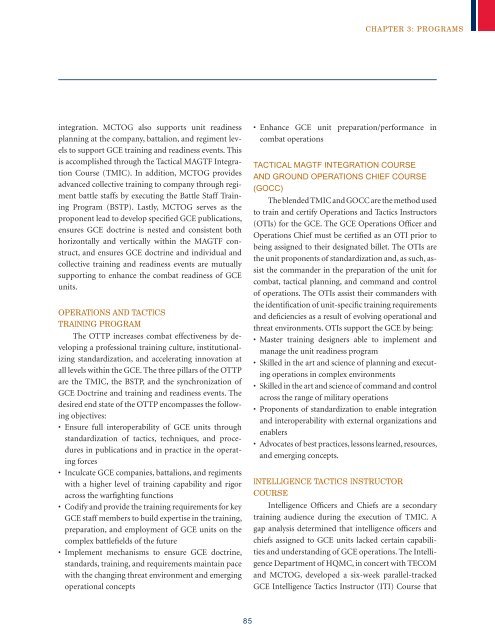USMC Concepts & Programs 2013 - Defense Innovation Marketplace
USMC Concepts & Programs 2013 - Defense Innovation Marketplace
USMC Concepts & Programs 2013 - Defense Innovation Marketplace
You also want an ePaper? Increase the reach of your titles
YUMPU automatically turns print PDFs into web optimized ePapers that Google loves.
chapter 3: programs<br />
integration. MCTOG also supports unit readiness<br />
planning at the company, battalion, and regiment levels<br />
to support GCE training and readiness events. This<br />
is accomplished through the Tactical MAGTF Integration<br />
Course (TMIC). In addition, MCTOG provides<br />
advanced collective training to company through regiment<br />
battle staffs by executing the Battle Staff Training<br />
Program (BSTP). Lastly, MCTOG serves as the<br />
proponent lead to develop specified GCE publications,<br />
ensures GCE doctrine is nested and consistent both<br />
horizontally and vertically within the MAGTF construct,<br />
and ensures GCE doctrine and individual and<br />
collective training and readiness events are mutually<br />
supporting to enhance the combat readiness of GCE<br />
units.<br />
Operations and Tactics<br />
Training Program<br />
The OTTP increases combat effectiveness by developing<br />
a professional training culture, institutionalizing<br />
standardization, and accelerating innovation at<br />
all levels within the GCE. The three pillars of the OTTP<br />
are the TMIC, the BSTP, and the synchronization of<br />
GCE Doctrine and training and readiness events. The<br />
desired end state of the OTTP encompasses the following<br />
objectives:<br />
• Ensure full interoperability of GCE units through<br />
standardization of tactics, techniques, and procedures<br />
in publications and in practice in the operating<br />
forces<br />
• Inculcate GCE companies, battalions, and regiments<br />
with a higher level of training capability and rigor<br />
across the warfighting functions<br />
• Codify and provide the training requirements for key<br />
GCE staff members to build expertise in the training,<br />
preparation, and employment of GCE units on the<br />
complex battlefields of the future<br />
• Implement mechanisms to ensure GCE doctrine,<br />
standards, training, and requirements maintain pace<br />
with the changing threat environment and emerging<br />
operational concepts<br />
• Enhance GCE unit preparation/performance in<br />
combat operations<br />
Tactical MAGTF Integration Course<br />
and Ground Operations Chief Course<br />
(GOCC)<br />
The blended TMIC and GOCC are the method used<br />
to train and certify Operations and Tactics Instructors<br />
(OTIs) for the GCE. The GCE Operations Officer and<br />
Operations Chief must be certified as an OTI prior to<br />
being assigned to their designated billet. The OTIs are<br />
the unit proponents of standardization and, as such, assist<br />
the commander in the preparation of the unit for<br />
combat, tactical planning, and command and control<br />
of operations. The OTIs assist their commanders with<br />
the identification of unit-specific training requirements<br />
and deficiencies as a result of evolving operational and<br />
threat environments. OTIs support the GCE by being:<br />
• Master training designers able to implement and<br />
manage the unit readiness program<br />
• Skilled in the art and science of planning and executing<br />
operations in complex environments<br />
• Skilled in the art and science of command and control<br />
across the range of military operations<br />
• Proponents of standardization to enable integration<br />
and interoperability with external organizations and<br />
enablers<br />
• Advocates of best practices, lessons learned, resources,<br />
and emerging concepts.<br />
Intelligence Tactics Instructor<br />
Course<br />
Intelligence Officers and Chiefs are a secondary<br />
training audience during the execution of TMIC. A<br />
gap analysis determined that intelligence officers and<br />
chiefs assigned to GCE units lacked certain capabilities<br />
and understanding of GCE operations. The Intelligence<br />
Department of HQMC, in concert with TECOM<br />
and MCTOG, developed a six-week parallel-tracked<br />
GCE Intelligence Tactics Instructor (ITI) Course that<br />
85

















